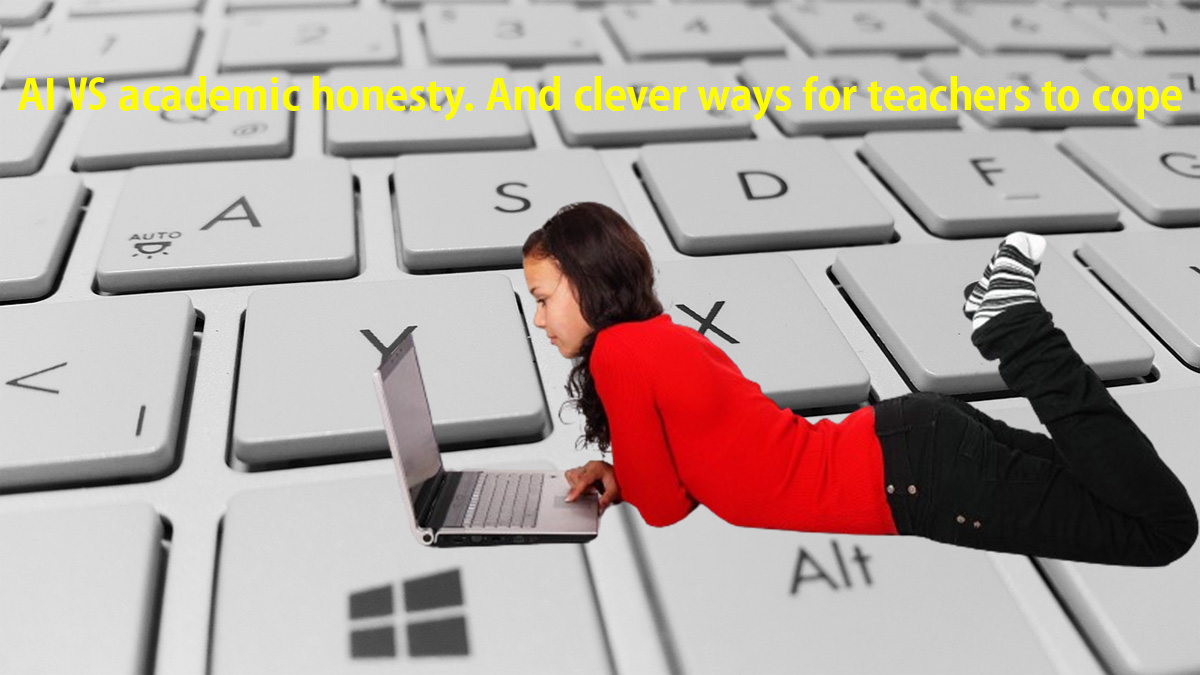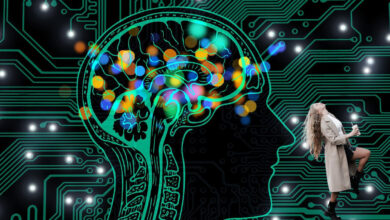AI VS academic honesty. And clever ways for teachers to cope

With the rapid growth of AI tools available that are capable of generating text, images, and even audio, there’s a growing concern about their misuse in academic settings and potential impact on academic integrity.
Students can now easily generate essays, research papers, and other assignments using AI-powered tools, specifically sparking concerns about the classroom implications of AI plagiarism and fabrication.
As technology continues to advance at a rapid pace, the use of AI tools in education has become more prevalent. While these tools can be incredibly helpful for students in terms of research and productivity, they also pose a significant threat to academic integrity.
One of the main concerns surrounding the use of AI tools in academia is the potential for plagiarism. With the ability to generate text that mimics human writing, students may be tempted to use AI-generated content as their own work without proper citation or attribution.
This not only undermines the value of education but also violates ethical standards and academic honesty.
Furthermore, there is a risk of fabrication when it comes to using AI tools for academic purposes. Students may rely on these tools to create false data or information that supports their arguments, leading to inaccurate research findings and misleading conclusions. This not only compromises the quality of education but also erodes trust in academic institutions.
In order to address these concerns, educators must take proactive measures to educate students about the ethical use of AI tools in academic settings.
By promoting critical thinking skills and emphasizing the importance of originality and integrity in research and writing, educators can help prevent misuse of AI tools and uphold academic standards.
Ways educators can address these concerns
Academic integrity is crucial in education as it lays the foundation for critical thinking, creativity, and knowledge acquisition. However, with the rise of technology, concerns about plagiarism and fabrication have become more prevalent in classrooms.
Educators must take proactive measures to combat these issues and ensure that their students are still learning effectively.
One way educators can address these concerns is by teaching students about the importance of academic honesty and integrity.
By educating students on what constitutes plagiarism and fabrication, they can help them understand the consequences of such actions and how it can impact their academic and professional future.
Another strategy educators can implement is utilizing technology to detect plagiarism. There are many online tools available that can help teachers identify instances of plagiarism in student work. By using these tools, educators can quickly identify any potential issues and address them before they escalate.
Furthermore, fostering a culture of honesty and integrity in the classroom is essential. Educators should encourage open communication with their students and create a supportive environment where students feel comfortable discussing any concerns they may have about their work.
Understanding AI-driven plagiarism and fabrication among students
In today’s digital age, the rise of artificial intelligence has brought about new challenges in academic integrity. One such challenge is the prevalence of AI-driven plagiarism and fabrication among students. With the increasing availability of AI tools that can generate essays, reports, and even entire research papers, students are tempted to take shortcuts in their academic work.
AI-driven plagiarism occurs when students use AI-powered tools to copy and paste content from sources without proper citation. This not only violates academic integrity but also undermines the learning process. Similarly, fabrication involves creating false information or data to support a claim or argument, which can be easily done with the help of AI algorithms.
To combat this issue, educators and institutions need to educate students about the ethical use of AI tools and the importance of originality in academic work. They should also implement strict policies and procedures for detecting and penalizing instances of AI-driven plagiarism and fabrication.
Explaining Plagiarism
With the advent of new and widely available AI tools and features, plagiarism—which is usually defined as the use of another person’s work without giving due credit—has taken on new dimensions.
Artificial intelligence (AI) algorithms have the ability to produce text that closely mimics human writing, making it more difficult to identify cases of plagiarism. Plagiarism is when content produced by AI is used without proper credit.
An explanation of fabrication
Moreover, educators who aim to uphold academic integrity in the classroom face additional difficulties when it comes to fabrication, which is the creation of completely false knowledge.
Teachers have observed that students will turn in essays that are well cited and include a wealth of information, only to discover later that the citation was entirely made up using authors, papers, and websites that sound similar to ones that already exist in the area.
The Effects of AI Fabrication and Plagiarism in the Classroom
1- Obstructing the learning of students
Pupils need to be aware of the grave repercussions of plagiarism and fabrication. The cornerstone of academic integrity is undermined by these unethical actions, endangering the moral development and reasoning of pupils.
Academic consequences are not the only negative impact of dishonesty; it also jeopardizes students’ learning and growth. Students who use artificial intelligence (AI) technologies to create content skip over critical thinking, analysis, and synthesis processes, which stunts their intellectual development and makes it more difficult for them to interact with the material in-depth.
2- More Work and Hours for Teachers
As standard plagiarism detection technologies may find it difficult to distinguish between real and AI-generated content, the task of identifying AI-generated content is becoming increasingly challenging.
In addition to the already overwhelming amount of work educators already have, they also need to keep up with the most recent technological advancements and continuously update their methods for identifying and stopping academic dishonesty.
3- Social and Moral Issues
By deepening the divide between rich and underprivileged pupils, these behaviors amplify already-existing inequalities in access to resources and education.
Poor students could not have the resources to compete on an equal basis, whereas wealthy students might have access to advanced AI technologies and private tutoring programs that encourage academic dishonesty.
Thus, AI fabrication and plagiarism perpetuate institutional impediments to educational equity and opportunity as well as worsen social inequities.
In order to create a more equitable and just educational system that enables every student to flourish, stakeholders can support ethical behavior, cultivate a culture of academic integrity, and fight for equal access to education.
Ingenious Ways for Teachers to Stop AI-Generated Copying and Fabrication
1- Teach Students
Students should be made aware of the consequences of AI fabrication and plagiarism in the classroom first and foremost. To assist students succeed right away, establish clear expectations for assignments and offer advice on appropriate citation techniques.
By educating students about the dangers and repercussions of academic dishonesty, teachers may equip them to make wise judgments and withstand the urge to employ AI tools in an unethical manner.
2- Make use of AI plagiarism detectors
AI plagiarism detectors assist educators spot questionable similarities and conduct more research when needed by using complex algorithms to evaluate material and compare it to a database of reliable sources.
since a proactive strategy to discourage plagiarism and support academic integrity, educators can incorporate AI plagiarism checkers or detectors into their grading and assessment procedures. However, be aware of its limitations since it won’t catch everything.
3- Enhancing Assessment Methods to Combat AI Reliance
- Peer reviews are another valuable assessment method that can help deter students from relying on AI tools. By having students evaluate each other’s work, educators can foster a sense of collaboration and accountability among peers. Peer reviews also provide valuable feedback that can help students improve their critical thinking and analytical skills.
- Projects and in-class assignments/discussions are additional alternatives to written assignments that can promote deep engagement with course material. By designing assignments that require students to apply concepts learned in class to real-world scenarios, educators can encourage critical thinking, analysis, and synthesis. In-class discussions also provide an opportunity for students to share their unique insights and perspectives on course material.
4- Advocating for Policy Changes to Address AI Plagiarism in Education
Investing in advanced detection software is essential to effectively identify instances of AI plagiarism. By utilizing cutting-edge technology, educators can detect suspicious patterns or anomalies in student work and take appropriate action to address any violations.
Additionally, providing support for educators through training and resources can help them navigate the complexities of AI plagiarism and uphold academic standards within their classrooms.
Collaborative efforts are key to implementing comprehensive solutions that address AI plagiarism in education.
By advocating for policy changes that prioritize academic integrity and accountability, we can create a learning environment where honesty and ethical behavior are valued above all else. Together, we can ensure that students are held responsible for their actions and uphold the principles of integrity in education.
5- Encourage Originality
Encouraging originality in students is crucial for fostering critical thinking and creativity. Educators can design assignments that challenge students to think outside the box and come up with unique solutions.
By incorporating project-based learning, blended learning, cognitive learning, case studies, and problem-solving tasks, educators provide opportunities for students to showcase their individual perspectives and insights.
Rewarding innovative approaches and emphasizing the value of original thought not only reduces the temptation for students to engage in dishonest practices but also motivates them to engage more deeply with course material.
When students are encouraged to think creatively and produce authentic work, they are more likely to develop a deeper understanding of the subject matter.
One way educators can easily incorporate interactive tools into their teaching is by using ClassPoint in PowerPoint presentations.
With ClassPoint, students can respond to questions using images, videos, audio recordings, or by drawing, allowing for a more engaging and interactive learning experience. By encouraging students to express themselves in different ways, educators can help them tap into their creativity and originality.
6- Open Dialogue in Education
Maintaining open lines of communication with students is crucial for fostering a positive and productive learning environment.
By encouraging an open dialogue, educators can address any concerns or misunderstandings that may arise, clarify expectations, and reinforce the importance of academic integrity.
Creating a supportive atmosphere where students feel comfortable discussing their academic challenges and seeking guidance is essential.
This can be achieved through regular feedback sessions, office hours, and class discussions. By engaging in proactive communication strategies, educators can build trust and transparency with their students.
Encouraging students to voice their questions and concerns not only helps to address issues promptly but also reduces the likelihood of academic dishonesty. When students feel heard and supported, they are more likely to stay engaged in their studies and strive for success.
7- Promoting Academic Integrity in Education
Academic integrity is a fundamental aspect of education that educators must prioritize and instill in their students. By emphasizing the importance of honesty, integrity, and fairness in academic work, educators can help students develop strong ethical values that will serve them well throughout their academic and professional careers.
One effective way for educators to promote academic integrity is through clear communication. By including information about academic integrity in course syllabi and discussing it in class, educators can ensure that students understand the expectations and consequences related to plagiarism, cheating, and other forms of academic dishonesty.
In addition to communication, educators can also model ethical behavior themselves. By demonstrating honesty and integrity in their own work, educators set a positive example for their students to follow. Holding students accountable for their actions when they violate academic integrity policies is another important step in reinforcing the values of honesty and fairness.
To make lessons on academic integrity more engaging and interactive, educators can use tools like ClassPoint to design assessments that teach these important concepts. With features like Quiz Mode, Multiple Choice Questions, Short Answer questions, and Fill-in-the-Blanks exercises, educators can create fun and informative activities that keep students interested while reinforcing the principles of academic integrity.
By promoting academic integrity through effective communication, modeling ethical behavior, holding students accountable, and using interactive assessments, educators can help ensure that their students develop a strong foundation of honesty and integrity that will benefit them both academically and professionally.
8- Adopt Technology Responsibly
Modeling ethical behavior when using AI tools can set a positive example for students and encourage them to think critically about their own actions.
By promoting ethical practices in technology use, educators can help shape a generation of responsible digital citizens who are equipped to make informed decisions in an increasingly tech-driven world.
Embracing technology ethically in education is not just about utilizing the latest tools; it’s about instilling values of integrity, respect, and responsibility in our students.
By teaching them how to use AI tools ethically, we are preparing them for success in a rapidly evolving technological landscape while also shaping them into conscientious global citizens.







